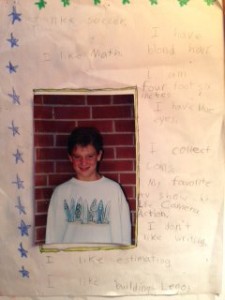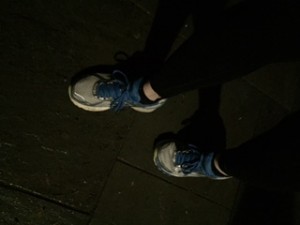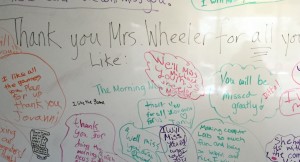One of our school-wide goals this year is to increase opportunities for students to be innovative. When George Couros, author of The Innovator’s Mindset, visited our school recently, he was impressed with our efforts towards this goal and shared that in his travels he usually sees these efforts taking place in middle and high schools. George quickly agreed with me that elementary kids certainly have the curiosity to explore and create. So, I wonder, can elementary students be innovative?
If the genesis of innovative practice begins with new ideas, then I would argue that young children may be more naturally inclined to innovate than older students. Here’s why: they are naturally curious. Spend time with any 5 year old and you will remember just how curious they are. They are extremely creative. Give a kid a crayon, or a set of blocks, and sit back and watch. And don’t just watch but ask questions – “Why did you put this block here?” I guarantee you will hear responses you were not expecting.
Sir Kenneth Robinson warns us that “schools kill creativity,” I don’t know that I would go that far, but I don’t think we do enough to foster opportunities for kids to create and experience the sheer joy of creating. Recently, there are some movements to integrate the arts into the classroom, rather than having “specials” as a separate experience for our students. The intent is to link art, music, computer, and P.E. into our various subject areas in a more authentic manner. I worry about this thinking. We still need to provide foundational skills in all subject areas – including the arts, but what we need to do more of is to encourage students to create and innovate as they are applying their learning. If we don’t add more creation time, we will continue to “kill” the joy of creation and the intense drive that this joy brings to motivating students to apply content taught, and fuel their desire to seek out further learning through independent exploration. The powerful joy of intrinsic motivation that Daniel Pink speaks of in his book Drive is lacking in many schools.
A few words about Noble… he was a student who wanted to learn many things by doing. He knew that in order for learning to be meaningful, he needed to experience its purpose so that he could connect the learning to improve his life, and eventually share these heightened states of learning with others. For Noble, this began with independent study: playing with blocks, Lego, Erector sets, puzzles, sandbox time, etc., he then graduated to building forts, tree houses, bridges, repairing boats, cars, and learning how to play instruments. Much of his initial learning was explorative play which included trial and error (risk-taking), stamina (perseverance), curiosity, and an innate need to feel joy through creation.
Noble is currently a successful Naval Architect, and by successful I mean that he experiences joy and satisfaction in the work that he does, the problems he finds and solves, and perhaps, most importantly, the balance in his life to explore his many interests. When he was a young boy we used to say he was immersed in his passion de jour as he went off to create and explore his varied interests.
At the age of 9 he noticed a problem at his dad’s marina. The marina began renting out a casual outside restaurant, located on their riverfront property, at the bottom of a steep hill called The Blue Oar. The restaurant served causal fare and became a popular weekend spot for diners in the summer months. The problem – no nearby bathroom. There was, however, a bathroom at the top of the hill that belonged to the boatyard. The restaurant customers were welcome to use this bathroom but it required a bit of a hike up a steep hill. Noble asked his dad if he could use the marina golf cart to transport customers up the hill so they could use the restroom without taking 20 minutes to climb up and down the steep hill. Of course, Noble also wanted to make some money. He was saving up to buy an old speedboat. He decided that rather than set a fixed fee for his services he might do better if he just let customers know that tips were certainly accepted. And that’s exactly what he did. I’m sure there may have been a misspelling and the notice was written on a plastic cup in kid writing. The cup was taped to the cart in the perfect location for customers to notice on their pleasant ride up the hill. But he never brought it up as he carried on pleasant chit-chat with customers during their bathroom excursion. Often, Noble made over $100 dollars a day in tips and he really added to the charm of the quaint dining experience along the river. Pretty creative and entrepreneurial thinking for a 9 year old kid, right?
When Noble was in high school he built a car from scratch – really. He also designed and built a pair of skis that he marketed, he taught himself how to play the guitar, wrote songs, formed a band and recorded a cd, learned how to fly a plane, bought and rebuilt a few old boats that he sold for profit, all this while working various full time jobs on weekends and summers. He was a good student, in several AP and honors classes, played sports all three seasons, got into his school of choice, and most importantly he was, and remains, a really nice guy. I remember getting a call from his high school math teacher one day; she was concerned that he was not doing his math homework. He was probably about 16 at the time, and I politely asked the teacher if he was aware of the consequences for this misbehavior. She assured me he was and this was puzzling to her. She shared that he certainly knew the material and that he was often capable of teaching the math to the other students, she just couldn’t understand why he wouldn’t take the time to complete the homework assignments. I think you know where I’m heading here and this is where it gets a bit controversial.
I understand that kids need to get the message that homework is part of their jobs as students in order to prepare them for higher learning institutions and “job like” expectations in their future. Most of us continue to have “homework” in our career of choice. I get it – but, what if these outside passions and innovations that Noble was engaging in could somehow be connected to his formal schooling? I would imagine the reason he didn’t spend time on his math homework was because he was so motivated to engage in the joy of learning he experienced with his many other endeavors. Obviously he needed both experiences (school and outside interests) to prepare him for his current success, but why did they need to be separated?
Every kid isn’t as intrinsically motivated to delve into independent learning projects as Noble. But is that because they haven’t experienced the joy of the efforts? What can we do to provide our students with more joy of learning? If we agree that humans have this innate desire to create and experience great joy through creation, then isn’t it our job to make sure we incorporate more opportunities for students to engage in this type of innovation through all stages of their education, so we don’t perhaps “kill” their innate creative tendencies? And, shouldn’t we begin these experiences with creative innovation early on in their education when they are just so darn curious and motivated to engage in creating?




